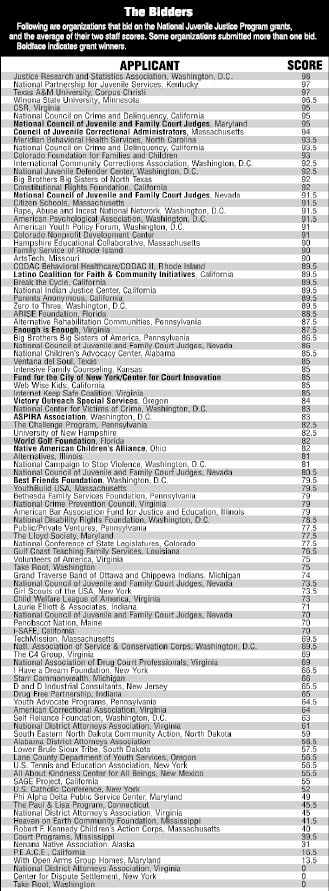One grant proposal was to improve evaluations of state juvenile justice programs. The two Justice Department reviewers loved it, each giving it scores of 98.
[module type=”aside” align=”right”]Here are PDFs of the winning bids. Here is a detailed list of bidders for OJJDP’s 2007 National Juvenile Justice Program grants (winners are highlighted).
Here is a spreadsheet of all OJJDP 2007 discretionary grants.
[/module]Another proposal was for a national center to improve juvenile corrections facilities through research, training and technical assistance. Reviewers loved that, too; it scored 98 and 96.
Then there was a proposal to teach kids life skills by playing golf. Its scores: 86 and 78.
Guess which bid won a competitive grant from the U.S. Office of Juvenile Justice and Delinquency Prevention (OJJDP).
The World Golf Association might, in the words of one unsuccessful bidder, “be a wonderful organization, and hopefully they’re making some contribution to kids.” But how did it’s First Tee Program recently win a National Juvenile Justice Program grant after scoring lower than 38 organizations that did not?
The same way another nonprofit, the Best Friends Foundation, won one of the 11 competitive grants even though it ranked 53rd – putting it behind 41 bids that OJJDP rejected.
The answer is OJJDP Administrator J. Robert Flores, who current and former Department of Justice (DOJ) officials say has repeatedly sought to fund organizations he favors, regardless of how they are ranked in the competitive bidding process – a process designed to avoid favoritism. One former official said that when it came to awarding grants, Flores “was bound and determined that he was going to give money to the people he wanted to.”
 While a government agency’s funding decisions often reflect the priorities and politics of those who run the agency – that, after all, is one advantage to being in charge – juvenile justice veterans in and out of the federal government say Flores has pushed that political reality to a new level driven by ideology.
While a government agency’s funding decisions often reflect the priorities and politics of those who run the agency – that, after all, is one advantage to being in charge – juvenile justice veterans in and out of the federal government say Flores has pushed that political reality to a new level driven by ideology.
In the case of the Juvenile Justice Program grants, OJJDP documents provide a window into how Flores’ agency decides which groups to fund. The documents show that OJJDP bypassed numerous high-scoring proposals by veteran youth-serving organizations and awarded grants to lower-scoring proposals.
Flores refused to discuss the grants, after repeated requests through the DOJ and when approached in person in a Senate hearing room – where he was about to testify about reauthorization of the Juvenile Justice and Delinquency Prevention Act, which created his agency in 1974 and regulates how it handles competitive bids.
Word has gotten out among organizations that scored high but didn’t win; some of them are furious and want OJJDP or Congress to explain the process. “We all play by the rules,” said Earl Dunlap, CEO of the National Partnership for Juvenile Services, whose losing bid ranked second out of 129. “The rules for Flores are pretty much whatever he decides when he gets out of bed in the morning.”
This story is based on OJJDP documents that were obtained unofficially, conversations with OJJDP staffers, interviews with three former DOJ officials, and interviews with winners and losers in the grant competition.
Great Opportunity

Krisberg: Submitted bid because “there seems to be a bunch of money” available.
Hopes ran high in the youth-service field when OJJDP asked for proposals last spring for the National Juvenile Justice Program grants. After years of seeing almost all of its discretionary funds eaten up by congressional earmarks, the agency now had millions of dollars to award through competitive bidding, thanks to the slashing of nearly all earmarks in fiscal 2007.
“We thought, ‘All right, let’s try to take advantage of the fact that there seems to be a bunch of money,’ ” said Barry Krisberg, president of the National Council on Crime and Delinquency.
Adding to the enthusiasm was that the Request for Proposals (RFP) was unusually broad; it said the purpose was to fund “programs that have a national scope and national impact on combating juvenile delinquency, reducing the victimization of children and improving the juvenile justice system.”
“Usually, the competitions are much more narrow,” Krisberg observed. “They’re much more about a specific project. This was a grab-bag.”
The RFP was divided into three categories: building protective factors to combat juvenile delinquency through positive activities (such as community service and sports) and among special populations (such as at-risk girls and tribal youth); reducing child victimization (focusing on Internet safety and sexual exploitation); and improving the juvenile justice system, including programs that address disproportionate minority contact and how courts handle abuse and neglect cases.
The broad RFP attracted organizations that never bid on or win OJJDP contracts – just the kind of expanded opportunity that many envisioned when Congress suspended earmarks.
“We never applied for [competitive] funding from them before,” said Betsy Brand, director of the American Youth Policy Forum, a Washington-based nonprofit that disseminates information about youth issues and facilitates policy discussions. The forum applied for the grant, she said, because “it was pretty open competition. … You could pretty much propose anything that you wanted to propose. We felt that gave us a better chance.”
But the broad RFP would also make it difficult for reviewers to compare bids that proposed to do so many different things, in many different ways, for different populations. “That probably wasn’t unintentional,” said a former DOJ official. That person noted that a broad grant description gives an agency lots of wiggle room for selecting winners, and speculated that “they wanted to have a great deal of freedom to reward their friends and punish their enemies.”
They also might not have had time to draft more specific RFPs; staffers say the proposal was rushed out the door.
Even before the bids were due on June 8, however, the pool of money available through competition was shrinking.
You Won – Please Apply
Congress might have taken a respite from earmarks, but OJJDP did not. As with other federal agencies, OJJDP routinely gives discretionary funds to favored organizations without competitive bidding.
Since taking the helm at OJJDP in 2002, Flores has repeatedly pushed to get agency money to organizations that fit his priorities, which include faith-based programs and those that combat child sexual victimization. Critics say that while some such programs deserve funding, OJJDP has favored them at the expense of other important areas of juvenile justice, such as issues in juvenile confinement.
Early this year, OJJDP sent letters to select organizations, asking them to submit proposals for the new grants, and in at least some cases told them the amount to request, according to several nonprofit leaders who received the letters. This is standard operating procedure in many federal agencies; it’s part of the discretion in discretionary grants. Some people call them “administrative earmarks.”
It appears that a dozen organizations won grants without competitive bidding. They were, by and large, national organizations that often get money through Congress or federal agencies without bids, such as the Boys & Girls Clubs of America, DARE America and the Cal Ripken Sr. Foundation.
That does not mean that all of the winners were chosen by Flores. For example, two people who’ve worked with Flores said he is not fond of the Ripken Foundation.
Scoring the Bids

Pion-Berlin: “I thought the process was totally competitive.”
“I thought the process was totally competitive.”
That’s an angry Lisa Pion-Berlin, CEO of Parents Anonymous, which did not win a grant even though its bid scored higher than seven bids that did.
One of the puzzles of this grant is how the bids were scored.
The RFP said the bids would be scored through peer reviews. Federal law and OJJDP guidelines require that competitive bids be reviewed by panels of peers (at least three experts) who are not employed by the agency giving the grants, although there are some exceptions.
In this case, the bids were scored by the agency’s staff – a process that most current and former DOJ staffers called unusual. The OJJDP records list 28 employees as reviewers, all of whom appear to be program managers. Each bid was reviewed by two of them.
One staffer said the reviewers had two days to score the bids, and that the agency’s senior staff members decided on the awards very soon thereafter.
A former DOJ official said a few department agencies do use some type of staff review for bids, although not simultaneously with outside peer reviews.
What’s unclear – and what OJJDP won’t say – is whether anyone outside the agency reviewed the bids.
Aside from listing staff scores, the agency documents include a “panel rank” of one through eight for most of the bids. The rankings don’t correspond to the winning bids. OJJDP staffers said the rankings were done by other agency employees.
According to the DOJ website, the Juvenile Justice and Delinquency Prevention Act “requires that programs be selected for OJJDP assistance through a formal peer review process using outside experts.” OJJDP’s Peer Review Guideline says, “It is OJJDP’s policy to use peer review to assess all competitive assistance applications.”
DOJ regulations list several exceptions to the peer review requirement, such as funds going to the State Advisory Groups, funds transferred to OJJDP from other agencies, and certain funds under sections 241f and 261e of the Juvenile Justice Act. (The latter addresses “special needs.”) It is not clear that those exceptions apply to this grant.
OJJDP did not respond to a request to cite its authority for using staff reviews for the grant or to say if it also conducted outside peer reviews. DOJ spokeswoman Summer Duncan said some of the bids were staff-reviewed and some peer-reviewed – which would be an odd mix within one program announcement. OJJDP did not respond to a request to explain that statement or answer other questions about the reviews.
One reason for the staff reviews would be a time crunch; it appears that OJJDP had to rush to get out the RFP, score the bids and award the grants.
While not commenting on this grant or OJJDP under Flores, former OJJDP Administrator Shay Bilchik noted the need for a transparent process.
“If you are going to have credibility with your field, they need to know that you have this peer review process, this independent input on the quality of the applications,” he said.
As for decisions made by staff, he said, directors need to be sure they “are transparent, and that you are establishing those criteria and documenting” your reasons for awarding and not awarding grants.
In the end, some staffers felt the review process didn’t matter.
Do Scores Matter?
Federal law does not say competitive grants must be awarded strictly in order of the scores given by reviewers; regulations and the RFP say they are “advisory.” While some federal agencies pretty much stick to scores when choosing grant winners, others are known to deviate.
According to a former DOJ official, Flores regularly veers from bid rankings – so much so that DOJ higher-ups sometimes have to make him or his staffers justify their choices. Flores was routinely “looking for an opportunity to give money to people he wanted to give money to,” the official said.
In at least one case, a former official said, Flores chose a faith-based organization with such a low score that the Office of Justice Programs, which must approve grant awards, told him no.
Flores has justified his method of operating by saying he wanted more diversity among grantees, according to DOJ staffers. One heard Flores say that “the highest scores are usually the ones that have the best grant writers, not the ones that have the best services.”
By that reasoning, the six top-scoring organizations that bid for the Juvenile Justice Program grants are living off great grant-writers; none of them won a grant. They included the Justice Research and Statistics Association, which for years has run the Juvenile Justice Evaluation Center under DOJ grants; the National Council on Crime and Delinquency; the National Partnership for Juvenile Services, a collaboration of four organizations; and CSR, a Virginia-based consulting firm that contracts with numerous federal agencies, including OJJDP.
“We were rather surprised,” said Joan C. Weiss, executive director of the top-scoring Justice Research and Statistics Association – especially because “we were encouraged to submit this” bid by OJJDP staffers.
Agencies have a variety of reasons to occasionally deviate from review rankings. Bilchik said the agency might want to achieve geographic variety among the grantees, or take into account a bidder’s poor performance on previous grants. He said that if such factors applied when he oversaw OJJDP, they would be explained in “decision memos” about the grants.
To be sure, several of the 11 winning bids went to well-regarded national organizations that have carried out federal contracts before, and that achieved scores that current and former DOJ officials say could justify grants. Three of the winners each had an average score of at least 90: the National Council of Juvenile and Family Court Judges (which submitted seven bids and won two grants), the Council of Juvenile Correctional Administrators and the Fund for the City of New York.
In some cases, the scoring difference between bids that won and those that did not is only one or two points. Those who have complained about not winning stress that they are not demeaning those that won. Their anger is about a process that they believe didn’t play out as they were told it would and that appears to have favored certain groups.
“Basically, he [Flores] said the process that you’ve gone through is meaningless to me. I’m going to do what I want to do,” said Dunlap of the National Partnership for Juvenile Services.
Winning Patterns
A comparison of winners and scores, according to OJJDP documents, shows that:
- Twenty-one bids with average scores of 90 or above did not win grants. Eight bids that scored below 90 did win grants.
- The highest-scoring bid that won a grant, from the juvenile court judges, scored in a three-way tie for fifth, with a 95 average. The next winning bid, from the Council of Juvenile Correctional Administrators, ranked eighth, with a 94.
- The next seven highest-scoring bids were passed over to get to the third winner, which was again the family court judges, this time with an average of 91.5.
- The lowest averages among the grant winners were for the golf foundation, with an 82, and the Washington-based Best Friends Foundation, with 79.5. Best Friends President Elayne Bennett – wife of Bill Bennett, a cabinet member under the first President Bush – did not return calls to discuss the grant.
- Several of the winners appear to fit Flores’ priorities in grant-making: Victory Outreach Special Services is faith-based; Enough is Enough targets Internet sexual exploitation of children; and the Best Friends Foundation’s curriculum, which steers youth from sexual intercourse, drugs and tobacco, includes abstinence-only education.
- One winner, Victory Outreach Special Services, said it will reject the grant because it doesn’t have the organizational capacity to carry it out.
- Some of the grants appear to be making up for funds that organizations lost when Congress dropped its earmarks. At the Cal Ripken Sr. Foundation, Executive Director Steve Salem said he saw the $3 million no-bid grant as a continuation of the foundation’s past earmark. Other past earmark winners that were invited to apply for no-bid grants included the World Golf Foundation and the Eisenhower Foundation (which got $3 million, down from its $4 million congressional earmark).
Some of the bid winners, however, said they have never received federal earmarks, and in some cases haven’t even gotten money from OJJDP. “This is our first time” getting a federal grant, said Linda Logan, executive director of the Native American Children’s Alliance, based in suburban Cleveland. “We’re used to lots of rejections.”
Reactions

Dunlap: “The rules for Flores are pretty much whatever he decides when he gets out of bed in the morning.”
Some of the spurned high scorers want Congress to examine how the agency awards grants that are supposed to be competitive. “People say we don’t like the earmark process because it so political,” said Pion-Berlin of Parents Anonymous. “Was this award process political?”Dunlap, of the Partnership for Juvenile Services, heard months ago that the coalition would not win one of the grants even though its score was among the highest. “If this is the case,” he wrote in a letter to Flores, “then the decision on funding reflects the idiosyncrasies of your leadership more so than the professional perspectives of your peer reviewers.”
In his letter to Flores, Dunlap charged that OJJDP has “abandoned the 50,000+ children/youth in juvenile confinement facilities” in favor of putting “disproportionate” resources into youth victimization. The letter notes that OJJDP funding of the National Juvenile Detention Association – one of the four organizations that makes up the Partnership for Juvenile Services – has gradually declined from $850,000 in 2000 to what appears to be zero in fiscal 2008.
Several agencies that did not win grants say they asked OJJDP for summaries of their reviews, but have been told it will take a while because the agency has received an unusual number of such requests.





























